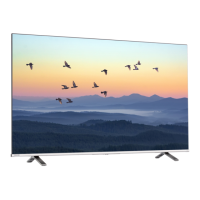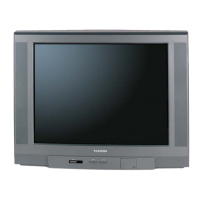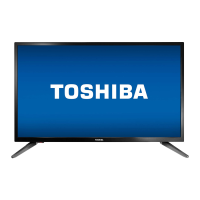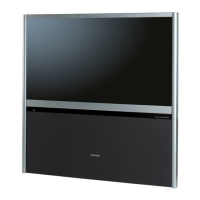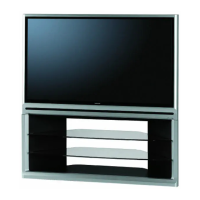Do you have a question about the Toshiba TV and is the answer not in the manual?
Essential safety rules for TV installation and usage.
Covers ventilation, heat, mains supply, and general safe operation.
Optimal placement for viewing and securing the TV.
Instructions for wall mounting and pedestal stand removal.
Safety guidelines for handling and storing 3D glasses.
Warnings about potential side effects and viewing practices for 3D.
Precautions for cleaning and protecting the shutter lenses.
Avoiding IR sensor blockage and viewing tips.
Importance of high-quality HDMI cables for 3D.
Advisories on reception, image retention, and exclusion clauses.
Precautions and rules for using the USB HDD recording function.
Visual guide to the remote control buttons and functions.
Instructions for battery insertion and remote operating range.
General guide to connecting various devices.
Details on Aerial, SCART, HDMI, and LAN connections.
Steps for connecting HDMI sources.
Using Audio Return Channel for amplified audio.
Lists the necessary HDMI cables for setup.
Steps for configuring REGZA-LINK setup and devices.
Connecting a PC via analogue RGB cable.
Connecting a PC via HDMI using an adaptor.
Steps for connecting to a wired home network.
Guide to wireless setup using WLAN adaptor.
Connecting TV to PC using Intel WiDi.
Instructions for powering the TV on and off.
Using the remote to access and control menus.
Details on TV physical buttons and device connections.
Overview of the 1st, 2nd, and 3rd menu layers.
Initial TV setup including language, country, and location.
Wireless network configuration via Wi-Fi router information.
Manual configuration of network name, security, encryption.
Manual IP, subnet mask, and gateway settings.
Verifying internet connectivity status.
Choosing between Broadcast Guide or MediaGuide.
Configuring the RF input for antenna or cable.
Initiating channel scan for antenna input.
Choosing the cable operator based on country.
Configuring scan type, frequency, modulation, and symbol rate.
Steps and options for manual analogue TV tuning.
Skipping, locking, and sorting channels for easier navigation.
How to skip channels using ATV Manual Tuning.
Moving and saving channels to desired positions.
Manual tuning for digital TV channels.
Tuning for cable TV using frequency and modulation.
Reordering channels and using line number jump.
Moving channels and analogue switch-off information.
Standby channel updates and display mode settings.
Accessing frequently used settings quickly.
Selecting channels via numbers or navigation buttons.
Selecting stereo, bilingual, or mono audio for programmes.
Requirements for 3D content: glasses, source, cable.
Names, functions, and charging of 3D glasses.
Changing between 2D, 3D, and Native modes.
Choosing Side by Side (SBS) or Top and Bottom (TB) formats.
How the 3D button operates in different modes.
Selecting 3D or 2D display modes via Quick Menu.
Changing display modes using settings or the 3D button.
Controlling TV behaviour upon 3D signal detection.
Setting and managing a PIN for 3D safety features.
Modifying the 3D effect level for 2D to 3D conversion.
Enabling start messages and locking display mode changes.
Disabling prompts and showing important 3D info.
Correcting blurred 3D by swapping eye images.
Adjusting volume levels and using the mute function.
Selecting Dual audio, Balance, Bass/Treble, Voice Enhancement.
Utilizing Dynamic Bass Boost and Stable Sound for audio quality.
Managing audio compression for digital TV programmes.
Reducing volume differences between sources.
Configuring sound output for headphones and TV speakers.
Providing narrative sound tracks for visually impaired users.
Options like WIDE, 4:3, SUPER LIVE, CINEMA, SUBTITLE, 14:9 for aspect ratios.
NATIVE, PC NORMAL, PC WIDE, and Dot by Dot display options.
Selecting preset picture styles like Dynamic, Standard, Game.
Customizing brightness, contrast, colour, and tint.
Restoring all picture settings to factory defaults.
Enabling advanced colour adjustment features.
Fine-tuning individual colour hues, saturation, and brightness.
Optimizing backlight using sensors and scene analysis.
Enhancing black/white levels and reducing MPEG noise.
Adjusting picture warmth or coolness by modifying red/blue tint.
Adjusting DNR, Active Vision, 4:3 Stretch, and Blue Screen.
Setting picture position, auto format, and picture still.
Restoring advanced picture settings to their default values.
WLAN adaptor compatibility and standards.
Radio frequency emissions and safety.
Restrictions and usage rules for the WLAN adaptor.
Step-by-step wireless setup via Wi-Fi router.
Manual configuration of network name, security, encryption.
Status, signal, mode, and security settings of wireless connection.
Automatic IP address configuration via DHCP.
Manually setting IP address, subnet mask, and gateway.
Configuring DNS addresses automatically or manually.
Verifying the TV's internet connectivity status.
Entering text using the on-screen keyboard.
Configuring media controllers and external device control.
How to change the TV's name for network identification.
Connecting and preparing a USB HDD for recording.
Recording the current programme with a single button press.
Steps to stop an ongoing recording.
Finding and scheduling programmes using genre search.
Scheduling recordings using the Electronic Programme Guide.
Scheduling recordings from programme information.
Checking, editing, or deleting programmed recording timers.
Accessing the Library screen to view recorded content.
Remote control operations during playback.
Managing recorded titles, protection, and personal mode.
Preventing accidental deletion of recorded titles.
Checking HDD space and setting recording preferences.
Setting start/end padding for programmed recordings.
Testing the USB HDD for proper operation.
Erasing data and preparing a USB HDD.
How the TV handles overlapping recording schedules.
Accessing cloud-based content services.
Enabling HbbTV services for interactive TV.
Connecting TV as a second display for a PC.
Managing a list of previously connected PCs.
Playing movies, music, and photos from USB.
Basic operation with USB devices, including Auto Start.
Enabling or disabling automatic Media Player launch.
Accessing media from a DLNA server.
Multi View for USB photos and DLNA DMS content.
Selecting files and folders within the Media Player.
Manually changing and viewing photo content.
Configuring slide shows, interval time, repeat, and zoom.
Choosing 2D or 3D playback modes for photos.
Selecting movies from DLNA server or USB device.
Changing between 2D and 3D modes for movies.
Selecting photos from a playlist and closing the viewer.
Choosing preferred subtitle and audio tracks.
Setting repeat modes, resuming playback, and using playlists.
Registering the TV to a DivX account for VOD services.
Navigating playback, chapters, and changing titles.
Setting repeat modes, selecting from playlists, displaying file info.
Disabling physical TV buttons while allowing remote operation.
Setting up timers for automatic channel tuning and programme viewing.
Configuring the TV to turn on automatically at a set time or channel.
Setting the TV to automatically switch off after a duration.
TV automatically turns off after inactivity or no signal.
Accessing details about current and upcoming programmes.
Meaning of various icons for service, audio, and recording status.
Guide for navigating and viewing broadcast programme information.
Retrieving details for highlighted programmes in the EPG.
Selecting content by genre and using search functions.
Accessing and using the integrated media guide.
Establishing a PIN for parental control features.
Adjusting programme rating levels and blocking content.
Restricting network access with a PIN.
Creating and managing lists of preferred channels.
Skipping specific channels in the tuning list.
Securing digital channels with a PIN to prevent access.
Configuring subtitle display and selecting audio tracks.
Inserting CAM modules for subscription broadcasts.
Managing software upgrades and viewing license details.
Viewing software version and diagnostic data.
Restoring TV to factory default settings.
Adjusting picture position for PC input signals.
Clearing picture artifacts like stripes and blur.
Clearing vertical lines by adjusting the sampling clock.
Returning PC settings to factory defaults.
Manually selecting TV input sources.
Assigning custom labels to video input ports.
Configuring audio format, delay, and output.
Activating REGZA-LINK, controlling amplifiers, and setting speakers.
Managing TV and device power states automatically.
Selecting connected REGZA-LINK devices as input sources.
Automatically detecting and switching to input sources.
Turning off connected devices when the TV enters standby.
Selecting Auto (Fastext) or List modes for text display.
Using Auto and List modes, including sub-pages.
Displaying text information over the video or returning to normal view.
Displaying index, pages, and revealing concealed text.
Holding pages, enlarging text, and temporarily erasing the screen.
Resolving issues with no picture/sound, colour, or controls.
Addressing locked channels and unavailable subscription services.
Understanding soundtrack selection and DTV audio problems.
Resolving stripes, blur, and HDMI device connectivity problems.
Troubleshooting network, REGZA-LINK, and wireless connectivity.
Addressing DVB-T/C, subtitles, analogue text, and colour problems.
Recovering PIN and resolving missing text/colour issues.
Resolving Media Player errors and 3D image display problems.
Addressing USB HDD issues and general troubleshooting steps.
Interpreting the status indicated by the LED lights.
Details on licenses for Dolby, HDMI, Adobe, DivX, Microsoft, DLNA, Rovi, DVB, MPEG, and Intel.
Instructions for cleaning the screen and cabinet safely.
Guidelines for environmentally friendly disposal of products and batteries.
Pinout and signal information for the 15-pin PC connector.
Details on VESA-DMT compliant signal formats for PC input.
Table of VESA compliant signal formats for HDMI inputs.
Table of resolutions, aspect ratios, frequencies, and 3D structures.
Details on supported photo formats, codecs, and resolutions.
Details on supported movie formats, codecs, and resolutions.
More supported movie formats, codecs, and resolutions.
Details on supported music file formats and codecs.
Comprehensive table of resolutions, aspect ratios, frequencies, and 3D structures.
Table of video formats, aspect ratios, frequencies, and 3D structures.
Visual explanation of Full and Half side-by-side 3D structures.
Supported broadcast systems and available input/output ports.
List of supplied and optional items like remotes, 3D glasses, and adaptors.
Essential safety rules for TV installation and usage.
Covers ventilation, heat, mains supply, and general safe operation.
Optimal placement for viewing and securing the TV.
Instructions for wall mounting and pedestal stand removal.
Safety guidelines for handling and storing 3D glasses.
Warnings about potential side effects and viewing practices for 3D.
Precautions for cleaning and protecting the shutter lenses.
Avoiding IR sensor blockage and viewing tips.
Importance of high-quality HDMI cables for 3D.
Advisories on reception, image retention, and exclusion clauses.
Precautions and rules for using the USB HDD recording function.
Visual guide to the remote control buttons and functions.
Instructions for battery insertion and remote operating range.
General guide to connecting various devices.
Details on Aerial, SCART, HDMI, and LAN connections.
Steps for connecting HDMI sources.
Using Audio Return Channel for amplified audio.
Lists the necessary HDMI cables for setup.
Steps for configuring REGZA-LINK setup and devices.
Connecting a PC via analogue RGB cable.
Connecting a PC via HDMI using an adaptor.
Steps for connecting to a wired home network.
Guide to wireless setup using WLAN adaptor.
Connecting TV to PC using Intel WiDi.
Instructions for powering the TV on and off.
Using the remote to access and control menus.
Details on TV physical buttons and device connections.
Overview of the 1st, 2nd, and 3rd menu layers.
Initial TV setup including language, country, and location.
Wireless network configuration via Wi-Fi router information.
Manual configuration of network name, security, encryption.
Manual IP, subnet mask, and gateway settings.
Verifying internet connectivity status.
Choosing between Broadcast Guide or MediaGuide.
Configuring the RF input for antenna or cable.
Initiating channel scan for antenna input.
Choosing the cable operator based on country.
Configuring scan type, frequency, modulation, and symbol rate.
Steps and options for manual analogue TV tuning.
Skipping, locking, and sorting channels for easier navigation.
How to skip channels using ATV Manual Tuning.
Moving and saving channels to desired positions.
Manual tuning for digital TV channels.
Tuning for cable TV using frequency and modulation.
Reordering channels and using line number jump.
Moving channels and analogue switch-off information.
Standby channel updates and display mode settings.
Accessing frequently used settings quickly.
Selecting channels via numbers or navigation buttons.
Selecting stereo, bilingual, or mono audio for programmes.
Requirements for 3D content: glasses, source, cable.
Names, functions, and charging of 3D glasses.
Changing between 2D, 3D, and Native modes.
Choosing Side by Side (SBS) or Top and Bottom (TB) formats.
How the 3D button operates in different modes.
Selecting 3D or 2D display modes via Quick Menu.
Changing display modes using settings or the 3D button.
Controlling TV behaviour upon 3D signal detection.
Setting and managing a PIN for 3D safety features.
Modifying the 3D effect level for 2D to 3D conversion.
Enabling start messages and locking display mode changes.
Disabling prompts and showing important 3D info.
Correcting blurred 3D by swapping eye images.
Adjusting volume levels and using the mute function.
Selecting Dual audio, Balance, Bass/Treble, Voice Enhancement.
Utilizing Dynamic Bass Boost and Stable Sound for audio quality.
Managing audio compression for digital TV programmes.
Reducing volume differences between sources.
Configuring sound output for headphones and TV speakers.
Providing narrative sound tracks for visually impaired users.
Options like WIDE, 4:3, SUPER LIVE, CINEMA, SUBTITLE, 14:9 for aspect ratios.
NATIVE, PC NORMAL, PC WIDE, and Dot by Dot display options.
Selecting preset picture styles like Dynamic, Standard, Game.
Customizing brightness, contrast, colour, and tint.
Restoring all picture settings to factory defaults.
Enabling advanced colour adjustment features.
Fine-tuning individual colour hues, saturation, and brightness.
Optimizing backlight using sensors and scene analysis.
Enhancing black/white levels and reducing MPEG noise.
Adjusting picture warmth or coolness by modifying red/blue tint.
Adjusting DNR, Active Vision, 4:3 Stretch, and Blue Screen.
Setting picture position, auto format, and picture still.
Restoring advanced picture settings to their default values.
WLAN adaptor compatibility and standards.
Radio frequency emissions and safety.
Restrictions and usage rules for the WLAN adaptor.
Step-by-step wireless setup via Wi-Fi router.
Manual configuration of network name, security, encryption.
Status, signal, mode, and security settings of wireless connection.
Automatic IP address configuration via DHCP.
Manually setting IP address, subnet mask, and gateway.
Configuring DNS addresses automatically or manually.
Verifying the TV's internet connectivity status.
Entering text using the on-screen keyboard.
Configuring media controllers and external device control.
How to change the TV's name for network identification.
Connecting and preparing a USB HDD for recording.
Recording the current programme with a single button press.
Steps to stop an ongoing recording.
Finding and scheduling programmes using genre search.
Scheduling recordings using the Electronic Programme Guide.
Scheduling recordings from programme information.
Checking, editing, or deleting programmed recording timers.
Accessing the Library screen to view recorded content.
Remote control operations during playback.
Managing recorded titles, protection, and personal mode.
Preventing accidental deletion of recorded titles.
Checking HDD space and setting recording preferences.
Setting start/end padding for programmed recordings.
Testing the USB HDD for proper operation.
Erasing data and preparing a USB HDD.
How the TV handles overlapping recording schedules.
Accessing cloud-based content services.
Enabling HbbTV services for interactive TV.
Connecting TV as a second display for a PC.
Managing a list of previously connected PCs.
Playing movies, music, and photos from USB.
Basic operation with USB devices, including Auto Start.
Enabling or disabling automatic Media Player launch.
Accessing media from a DLNA server.
Multi View for USB photos and DLNA DMS content.
Selecting files and folders within the Media Player.
Manually changing and viewing photo content.
Configuring slide shows, interval time, repeat, and zoom.
Choosing 2D or 3D playback modes for photos.
Selecting movies from DLNA server or USB device.
Changing between 2D and 3D modes for movies.
Selecting photos from a playlist and closing the viewer.
Choosing preferred subtitle and audio tracks.
Setting repeat modes, resuming playback, and using playlists.
Registering the TV to a DivX account for VOD services.
Navigating playback, chapters, and changing titles.
Setting repeat modes, selecting from playlists, displaying file info.
Disabling physical TV buttons while allowing remote operation.
Setting up timers for automatic channel tuning and programme viewing.
Configuring the TV to turn on automatically at a set time or channel.
Setting the TV to automatically switch off after a duration.
TV automatically turns off after inactivity or no signal.
Accessing details about current and upcoming programmes.
Meaning of various icons for service, audio, and recording status.
Guide for navigating and viewing broadcast programme information.
Retrieving details for highlighted programmes in the EPG.
Selecting content by genre and using search functions.
Accessing and using the integrated media guide.
Establishing a PIN for parental control features.
Adjusting programme rating levels and blocking content.
Restricting network access with a PIN.
Creating and managing lists of preferred channels.
Skipping specific channels in the tuning list.
Securing digital channels with a PIN to prevent access.
Configuring subtitle display and selecting audio tracks.
Inserting CAM modules for subscription broadcasts.
Managing software upgrades and viewing license details.
Viewing software version and diagnostic data.
Restoring TV to factory default settings.
Adjusting picture position for PC input signals.
Clearing picture artifacts like stripes and blur.
Clearing vertical lines by adjusting the sampling clock.
Returning PC settings to factory defaults.
Manually selecting TV input sources.
Assigning custom labels to video input ports.
Configuring audio format, delay, and output.
Activating REGZA-LINK, controlling amplifiers, and setting speakers.
Managing TV and device power states automatically.
Selecting connected REGZA-LINK devices as input sources.
Automatically detecting and switching to input sources.
Turning off connected devices when the TV enters standby.
Selecting Auto (Fastext) or List modes for text display.
Using Auto and List modes, including sub-pages.
Displaying text information over the video or returning to normal view.
Displaying index, pages, and revealing concealed text.
Holding pages, enlarging text, and temporarily erasing the screen.
Resolving issues with no picture/sound, colour, or controls.
Addressing locked channels and unavailable subscription services.
Understanding soundtrack selection and DTV audio problems.
Resolving stripes, blur, and HDMI device connectivity problems.
Troubleshooting network, REGZA-LINK, and wireless connectivity.
Addressing DVB-T/C, subtitles, analogue text, and colour problems.
Recovering PIN and resolving missing text/colour issues.
Resolving Media Player errors and 3D image display problems.
Addressing USB HDD issues and general troubleshooting steps.
Interpreting the status indicated by the LED lights.
Details on licenses for Dolby, HDMI, Adobe, DivX, Microsoft, DLNA, Rovi, DVB, MPEG, and Intel.
Instructions for cleaning the screen and cabinet safely.
Guidelines for environmentally friendly disposal of products and batteries.
Pinout and signal information for the 15-pin PC connector.
Details on VESA-DMT compliant signal formats for PC input.
Table of VESA compliant signal formats for HDMI inputs.
Table of resolutions, aspect ratios, frequencies, and 3D structures.
Details on supported photo formats, codecs, and resolutions.
Details on supported movie formats, codecs, and resolutions.
More supported movie formats, codecs, and resolutions.
Details on supported music file formats and codecs.
Comprehensive table of resolutions, aspect ratios, frequencies, and 3D structures.
Table of video formats, aspect ratios, frequencies, and 3D structures.
Visual explanation of Full and Half side-by-side 3D structures.
Supported broadcast systems and available input/output ports.
List of supplied and optional items like remotes, 3D glasses, and adaptors.

